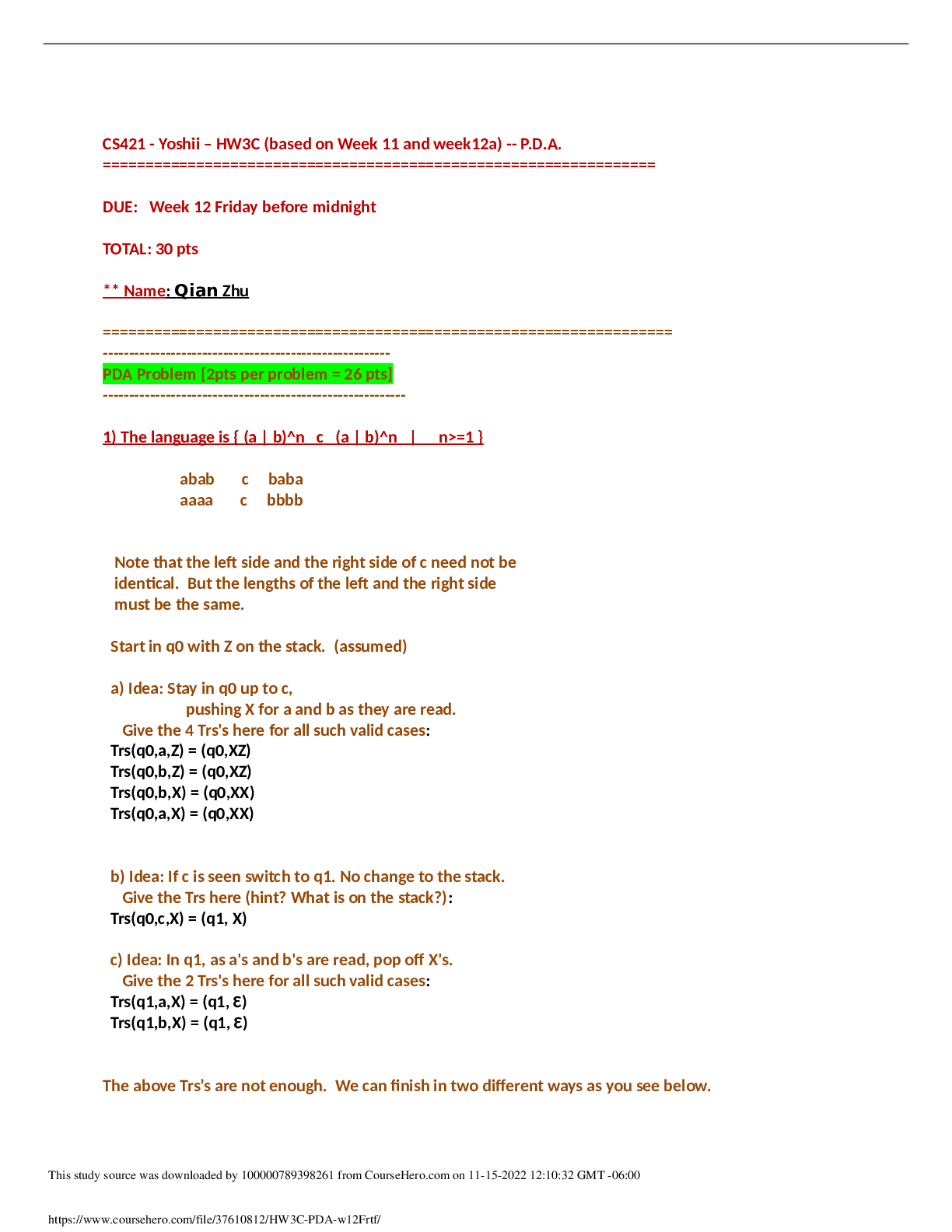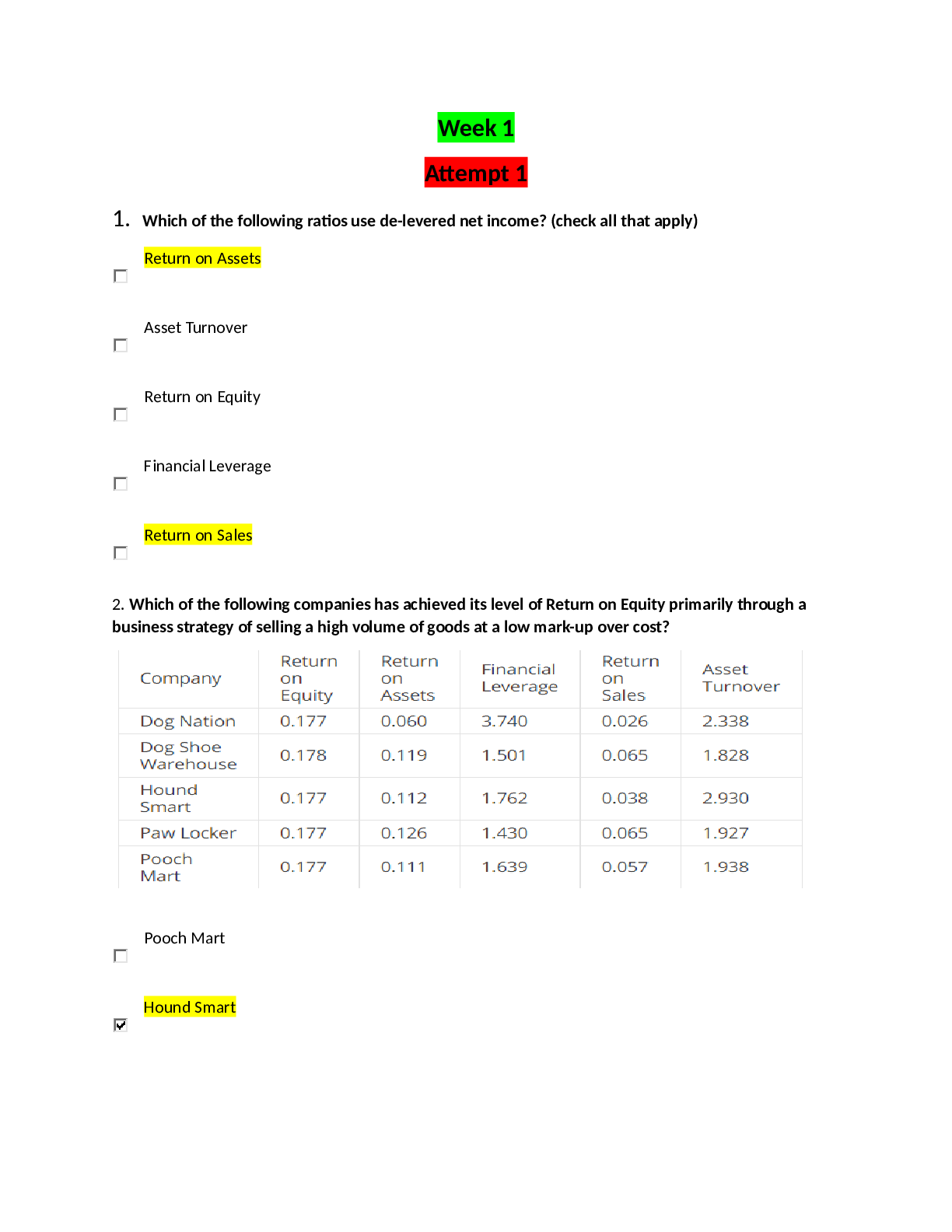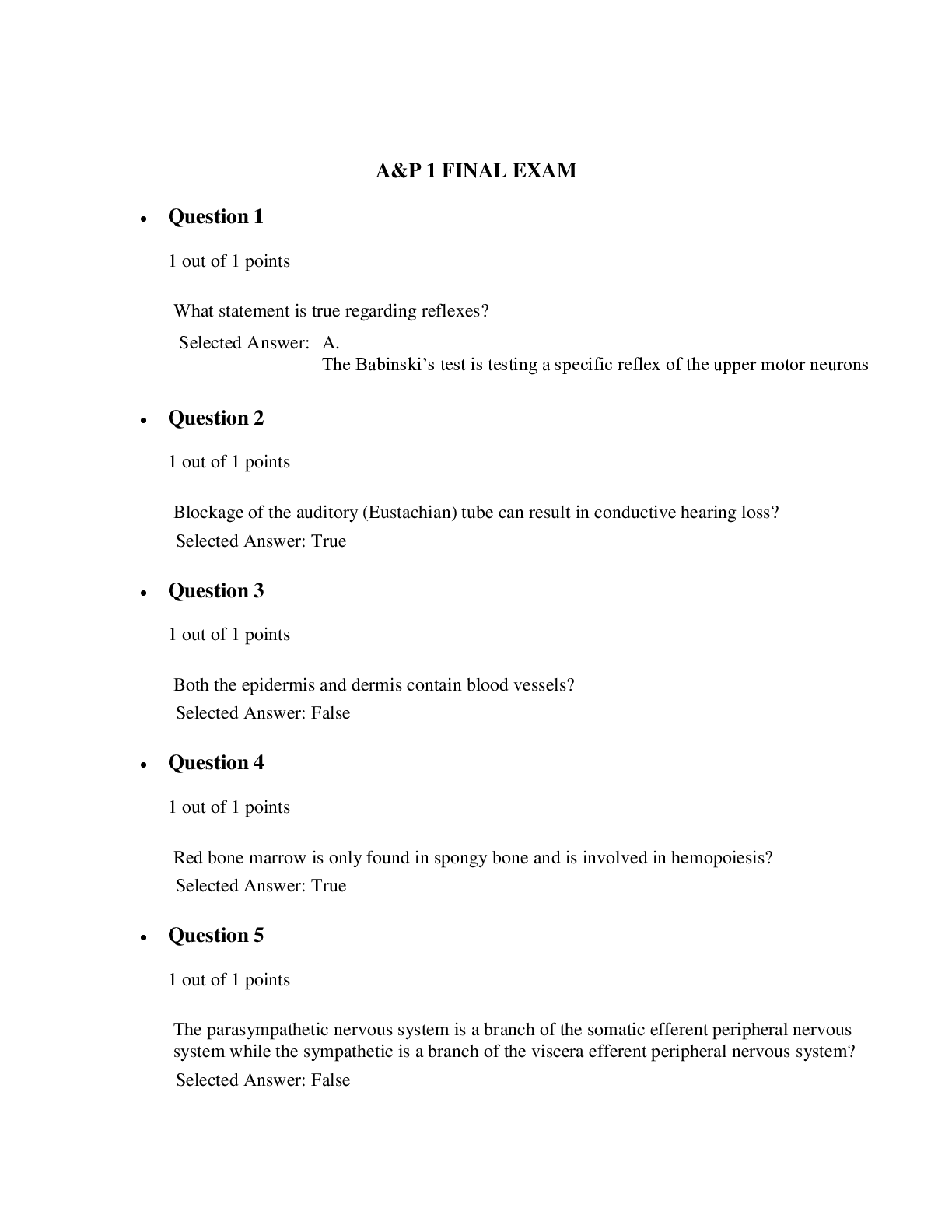*NURSING > QUESTIONS & ANSWERS > Rasmussen College: Practical Nursing - A&P 1 MA278/BSC2 Module 1 Case Study. Graded A (All)
Rasmussen College: Practical Nursing - A&P 1 MA278/BSC2 Module 1 Case Study. Graded A
Document Content and Description Below
Ben is a 6-month old infant who has a history of respiratory infections. His parents are concerned that his symptoms are worsening and bring him to his pediatrician, Dr. Johnson. They explain that he ... has a persistent cough and sometimes coughs up phlegm. He also experiences periodic wheezing and shortness of breath. Dr. Johnson notes that his weight and height have not increased as much as predicted since his last visit. He is concerned that Ben may have a genetic condition called Cystic Fibrosis. There are several ways to test for Cystic Fibrosis. In your own words, briefly describe 2 diagnostic tests that Dr. Johnson could use to determine if Ben has Cystic Fibrosis. 1. Cystic Fibrosis is an inherited condition. Which of the following describes the inheritance pattern? Autosomal recessive Autosomal dominant X-linked recessive X-linked dominant 2. List at least 3 other symptoms of Cystic Fibrosis that are not mentioned in the case study about Ben. 1: Salty tasting skin 2: Bulky, smelly, greasy bowel movements 3: Fatigue 3. Which of Ben's parents carried the defective gene which causes Cystic Fibrosis? His mother His father Both Parents Neither parent- this was passed on from a prior generation 4. If both of Ben’s parents are Cystic Fibrosis carriers and plan to have another child, what are the chances that their next child would NOT be a carrier and would NOT be affected by Cystic Fibrosis? 25% 50% 75% 0% 5. In your own words, briefly describe how the Cystic Fibrosis gene affects the cell membrane. 6. Which of the following is not a common treatment for Cystic Fibrosis? Pancreatic enzyme supplementation Frequent blood transfusions Using an inflatable vest that vibrates to loosen mucus in the chest Prescription medications, such as mucolytics, inhaled through a nebulizer . 7. In your own words, briefly describe why Ben’s skin may taste salty. 8. Which of the following statements is true of Cystic Fibrosis? A carrier of Cystic Fibrosis has a 100% chance of having a child with Cystic Fibrosis. Cystic Fibrosis is generally diagnosed between 20-40 years of age. Cystic Fibrosis involved multiple mutations of more than one gene. Cystic Fibrosis affects the ability of chloride ions to pass through the cell membrane. 9. Which tissue type is most affected by the excess mucus produced in Cystic Fibrosis? Connective tissue Muscle tissue Epithelial tissue Nervous tissue 10. Taylor, a 6-month-old infant, has recently been very fussy and appears to be in pain when his parents touch or squeeze his hands and feet. Both extremities have shown swelling that appears to be increasing slowly over time. He had a condition known as jaundice when he was born and his parents are noticing that his skin is starting to have that same yellowish color that it did when he was a newborn. Taylor’s parents are very concerned and take him to his pediatrician. Taylor’s pediatrician decides to perform blood tests because he is concerned that Taylor may have sickle cell disease. If he is correct, which of the following tests would be abnormal? WBC Platelets Hemoglobin HIV antibodies 11. Taylor’s test results provide a definitive diagnosis of sickle cell disease. Which other symptom would be common for his disease? Bleeding Fatigue Increased energy Weight gain 12. Why would the physician be interested in Taylor’s parents’ ethnicity? In your own words, provide a brief explanation of why ethnicity may be related to Taylor’s diagnosis. 13. Taylor’s parents have never been tested for sickle cell disease because they have never had any of the common signs or symptoms. Knowing that Taylor has sickle cell disease, which of the following statements is true? Taylor’s mother carries the gene for SCD and his father does not. Both of Taylor’s parents carry the gene for SCD. Taylor’s father carries the gene for SCD and his mother does not. This disease trait skips generations and neither of his parents is a carrier for the SCD gene. 14. If Taylor’s parents have another child, what is the likelihood that the second child will be a CARRIER of the sickle cell trait? 50% 100% 25% 0% 15. Sickle cell disease is a dominant disease, which means both parents of an affected individual must carry the sickle cell trait. True False 16. If a red blood cell is affected by sickle cell disease, which of the following is true? The nucleus of the red blood cell has genetic defects. The plasma membrane of the red blood cell allows too much fluid into the cell because of a hypotonic environment. Abnormal hemoglobin causes abnormal structure of the red blood cell. The plasma membrane of the red blood cell allows too much fluid into the cell because of a hypertonic environment. 17. Sickle cell disease can be detected by prenatal screening. In your own words, briefly describe this process. 18. Which of the following is NOT a possible treatment for sickle cell disease? Hematopoietic stem cell transplantation Liver transplant Red blood cell transfusions Preventative antibiotics 19. In your own words, briefly describe how sickle cell disorder affects homeostasis in the human body. [Show More]
Last updated: 2 years ago
Preview 1 out of 7 pages

Buy this document to get the full access instantly
Instant Download Access after purchase
Buy NowInstant download
We Accept:

Reviews( 0 )
$6.00
Can't find what you want? Try our AI powered Search
Document information
Connected school, study & course
About the document
Uploaded On
Feb 12, 2020
Number of pages
7
Written in
Additional information
This document has been written for:
Uploaded
Feb 12, 2020
Downloads
0
Views
55






.png)
.png)
.png)
.png)
.png)
.png)
.png)


